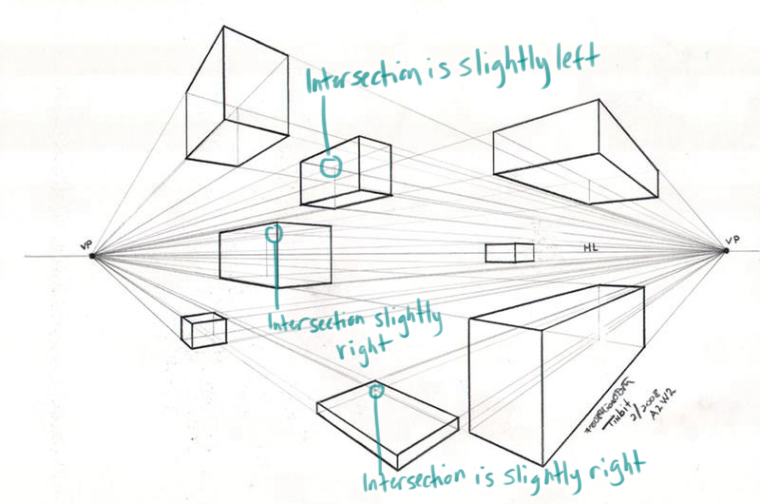How to Draw Everything: 2 point perspective question & feedback requested
-
Here's another tip, if you are struggling to draw/understand perspective, stop trying to do it from scratch. Make it a practice to draw using a photo and try to understand the perspective. You can use buildings or people, or whatever. Just grab a bunch of photos and try to make sense of it. Then you can use the photo perspective as a base to build your drawing from. THis makes it much easier and you will learn it very quick. I'm not sure why perspective isn't taught this way in school. Doing this simple exercise for a month would clear up almost every question you have about perspective.
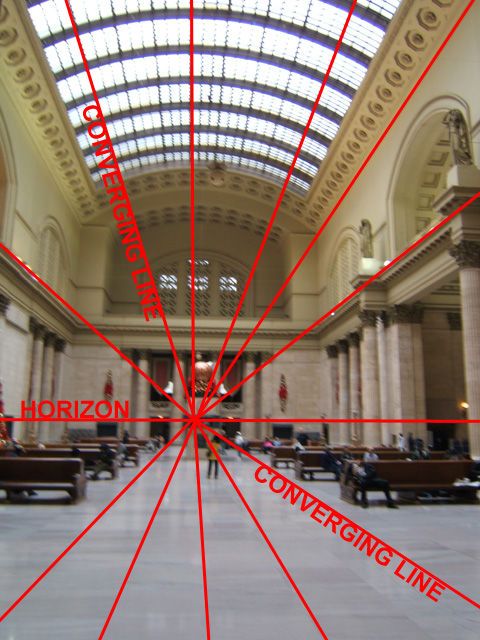
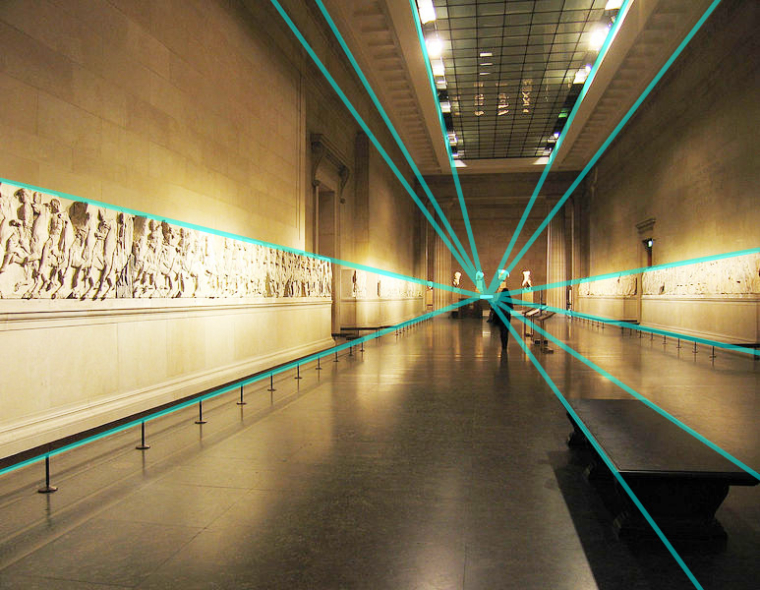
-
@lee-white Holy cow, what an obvious, and easy, exercise. Very helpful!
-
@lee-white I've always found it notoriously difficult to get those back corners to line up perfectly, even when I'm trying to be meticulous. In the example you posted, I can see where a couple of those back intersections aren't quite aligned with each other and the artist has placed that back corner nonetheless. Maybe I'm missing something, but that's what I consider fudging it- getting it very close, so it looks correct but not quite as close as a computer would. Am I wrong?
-
@tessw Can you show me where you are seeing the fudging the back corner in the example?
You shouldn't have to fudge it because it's basically math. What is probably happening with your drawings is that your grid isn't exactly right. maybe the lines don't go perfectly to the point on the horizon line, etc. That will cause a little shift in the perspective grid.
Using a perfect 2 point grid like I have here, It should line up perfectly every time.
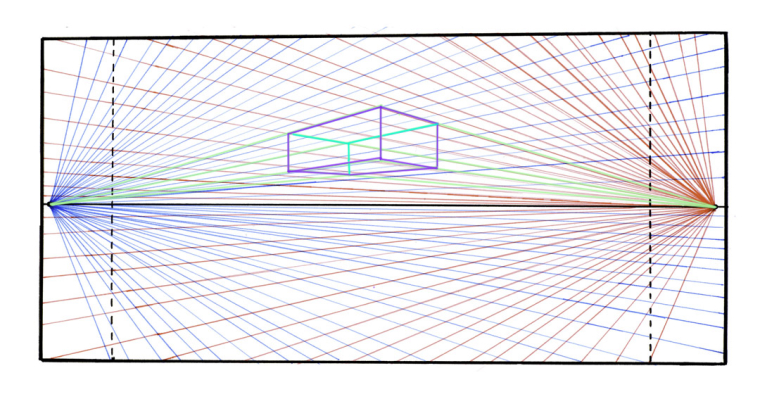
BTW, It really doesn't matter too much if it's perfect, as long as it looks right (as you mentioned). I just wanted to clarify that the math does work out to place that back corner if the grid and object are drawn correctly. Either way, it should never be as slanted as that drawing earlier in this post. Something went very wrong there.
-
Here's another way to think about it. You should be able to draw the back box first and it would work out to be correct too. Since it's math, starting at any side should still show the same results. Here's a box where I built it from the back wall first...
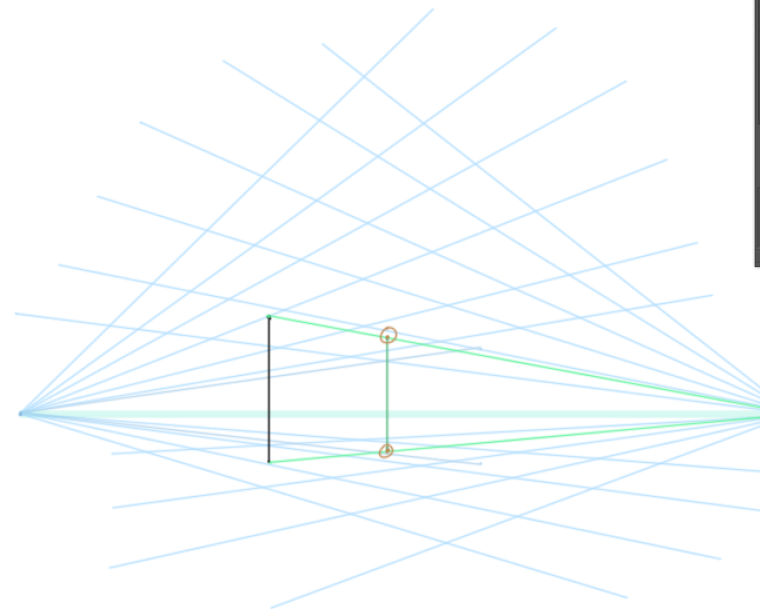
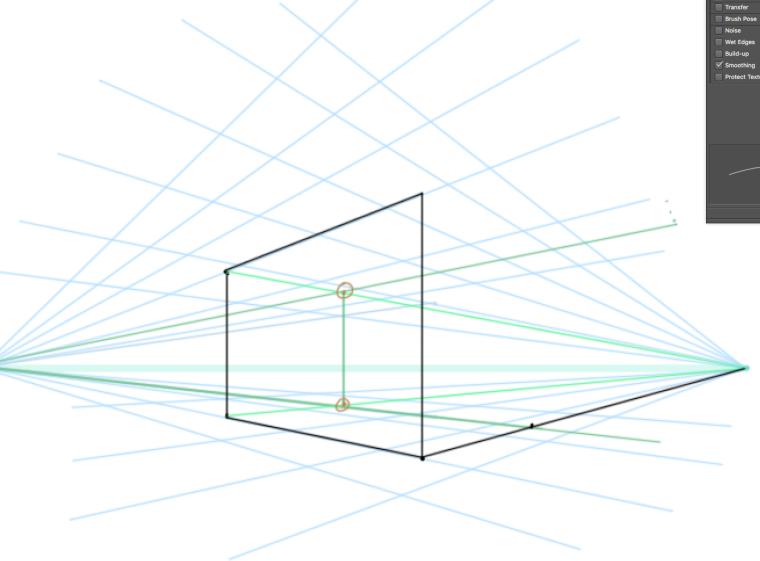
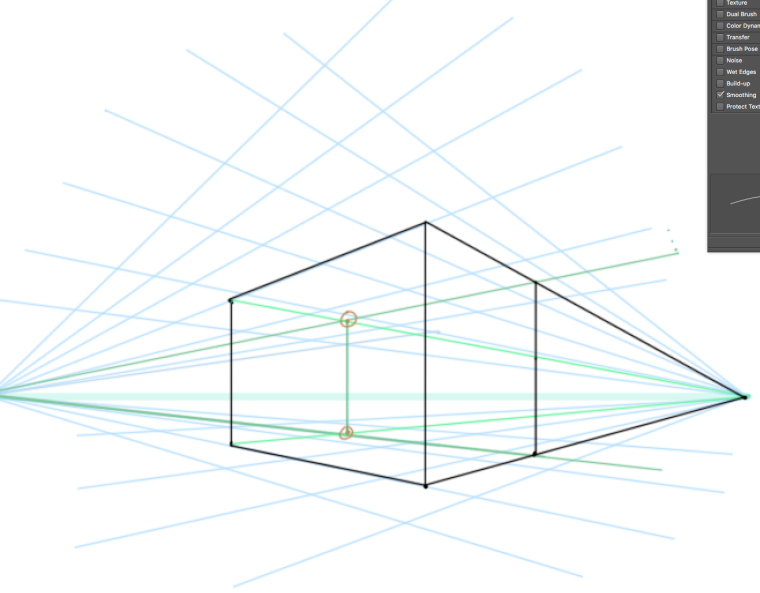
-
Using your drawing, I cleaned up the lines to the vanishing point, which causes the back to become correct again.
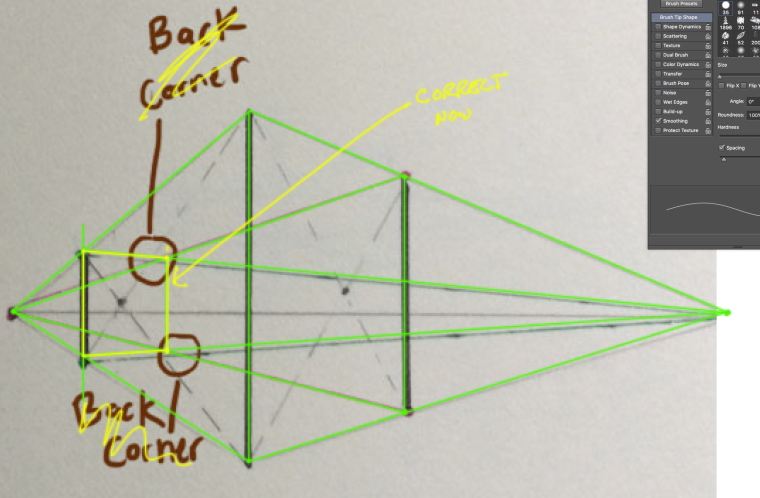
-
I've pointed out the areas where the intersections are off to me. I've done a lot of these myself using grids, and the results are very similar to the ones you posted. Some I can get "perfect", but with many the intersections are slightly offset and my straight vertical back corner doesn't quite hit dead center with both intersections, because even a small error of angle in any of the four vanishing lines affects it. It's even more obvious when you are zoomed in a bit while constructing these boxes. It always sort of bugged me, but after watching some perspective videos on svs where the tone is more relaxed, I figured it wasn't really all that important- hence my "fudging it" point of view. However, I don't want to encourage anyone to settle for less than what they are capable of, so maybe my advice was not appropriate. I just understand the frustration of feeling like you are taking time to do everything right, but still not quite hitting accuracy well enough.
On another note though- I will second the exercises overlaying the perspective lines on the photographs. Those were super helpful to me. After getting comfortable with these, at some point it might also be helpful to find photos with characters or objects in them and draw bounding boxes around them.
-
@lee-white the original drawing where the perspective is off and you did the overlay in yellow is my attempt to do the 2 point perspective exercise in "how to draw everything". I did that drawing freehand, but I recently learned the concept of a perspective grid and that procreate has that facility.
To make sure I understand what caused the problems with the freehand attempt--is it primarily the failure to accurately connect the red converging lines to the vanishing point on the left?
I have stepped back to using photos to identify vanishing points and horizon lines, but honestly have not found it that easy to visualize cubes in 2 point perspective with photos that consist mainly of people, even when I upload those photos into procreate and try to create a grid.
You used the word "math" quite a bit, sparking an immediate brain freeze--is it possible for those who are terrible in math to learn and apply perspective?
-
@bichonbistro haha, sorry for using the "M" word! It's not really math, but what I mean by that is that it's based on measurable things. In other words, it's not based on subjective things like other areas of art. If you make vanishing points that are correct, a box will work every time. So you don't really need "math" per se, but just take confidence that there is a consistent logic behind it.
If the perspective is off, it just means that something happened along the way that wasn't placed correctly. If the lines don't go back to the vanishing point cleanly, it will throw it off. Again, its not like you will get busted by the perspective police if you mess up here and there. I just wanted to show that the "fudging it" factor is not needed if the lines are correct. It's important to learn it correctly. But then throw that sucker away and draw cool stuff. No one has ever said "I hate that drawing, but man the perspective is exactly right!". There are people who will call you out on every little vanishing point, but those people don't see the forest for the trees.
Now, when doing the photo exercise, do NOT use photos of mainly people. People are almost useless in this. Use architecture and buildings, cars are good to so you can figure out how to box them out. For people, I just think about whether I'm drawing them from above, at eye level, or from below and let the perspective work out from there. After doing this professionally for the past 15 years I have never used vanishing points for a figure.
Hope that helps some. Good luck!
-
@lee-white Whew, thanks for avoiding the M-word
 isn’t it funny that the word “logic” is less threatening, even though that’s a subset of math?!
isn’t it funny that the word “logic” is less threatening, even though that’s a subset of math?!It is a bit intimidating to see how a very slight variance in line placement at vanishing points can so throw off perspective. I appreciate the clarification that while it is important to accurately learn the principles of perspective, don’t avoid drawing out of fear of the perspective police

Thanks for the advice to NOT use photos that consist primarily of people in trying to learn perspective—I was getting frustrated by that. I feel like I can breathe again knowing that I don’t need to precisely fit every character in a box in perfect perspective with heights accurately measured along converging lines when attempting to construct a scene with characters in it. It is very reassuring to read that you’ve never used vanishing points for figures in 15 years

I appreciate the help and encouragement from @TessW and you to finally learn principles that I have avoided for years. I keep telling myself it’s necessary to make a lot of mistakes to learn, but boy it’s hard to make marks knowing they are not going to match what is in your mind’s eye.
-
@bichonbistro said in How to Draw Everything: 2 point perspective question & feedback requested:
visualizing drawing in perspective
Thank you guys for the great support you are giving on this thread! Much appreaciated!
I'm doing currently the online course "Learn how to draw everything".
I understand the whole concept of the 2 point perspective.
When i draw a cube or a box with a ruler, the horizon and the guide lines its "easy" for me.
But when i start to draw cubes in perspective freehand, its giving me a hard time.Do you have any tipps on drawing cubes/boxes in perspective freehand?
Thank you,
Fritz
